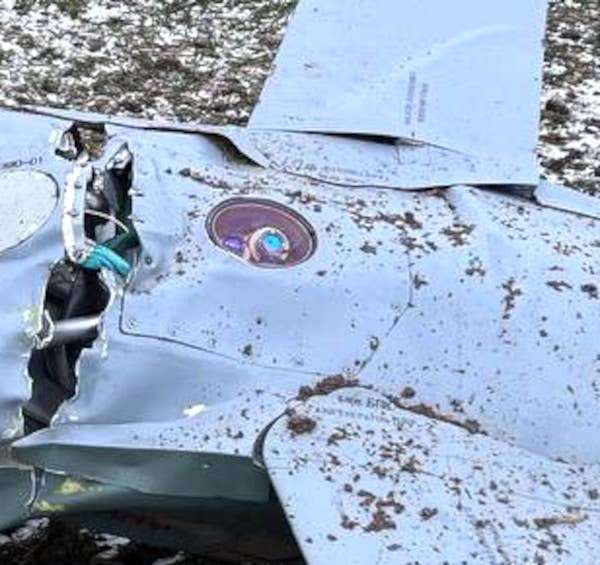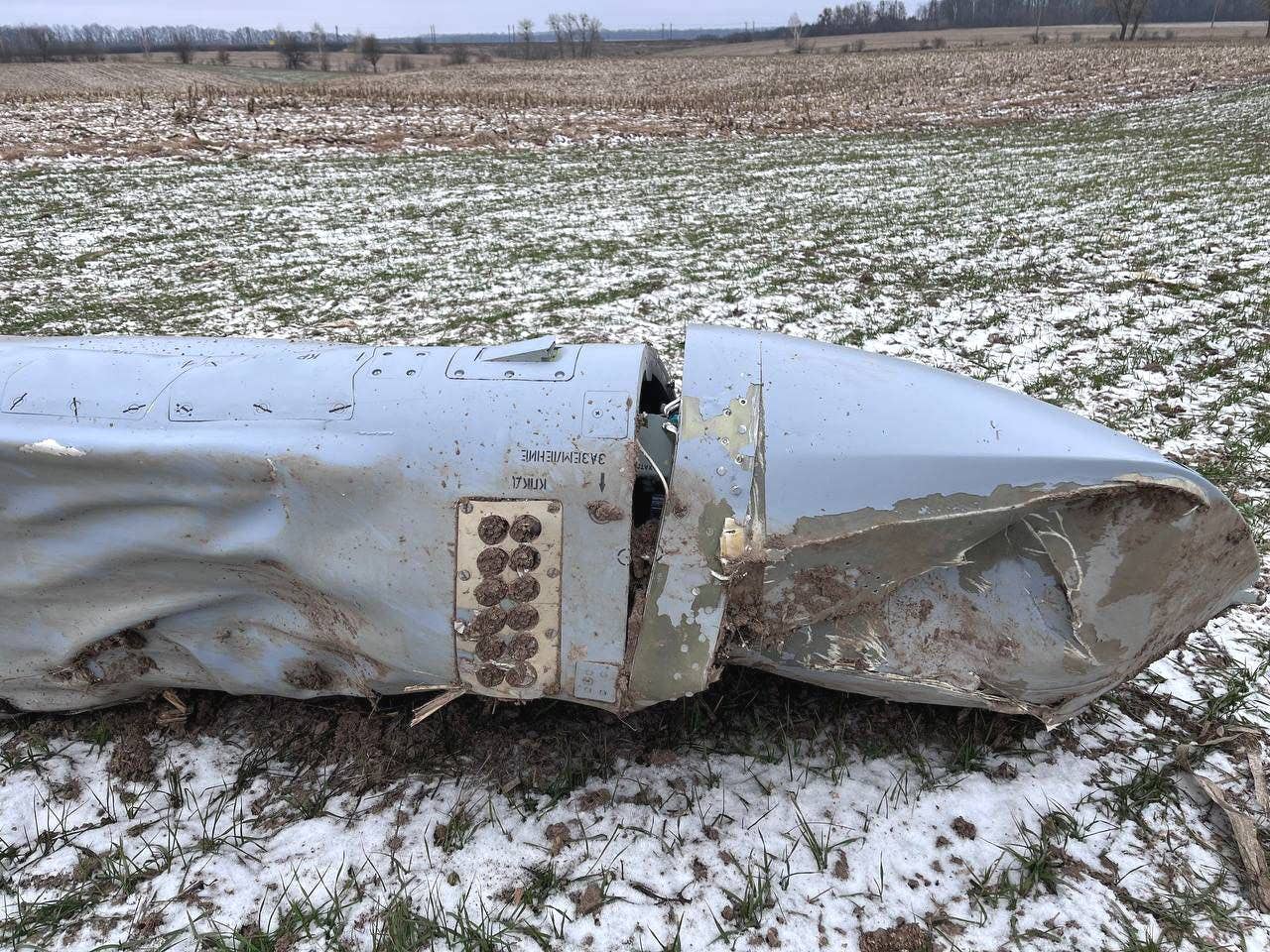Images have surfaced online of what appears to be the relatively intact remains of a downed Russian Kh-101 air-launched cruise missile, which offers a remarkably clear view of some of its features.
The Kh-101 in question was reportedly shot down by Ukraine’s air defense forces in the country’s central Vinnytsia region on January 26, as per the Facebook post from the Ukrainian Air Force.
In another Facebook post, the Ukrainian Air Force, which oversees the bulk of the country’s air defense forces, reported that a total of 55 air- and sea-launched missiles were fired by the Russian military on January 25, which included the air-launched Kh-101s, Kh-555s, Kh-59s, and Kinzhal hypersonic missiles, and the sea-launched Kalibr missiles.
Of these, 47 missiles were shot down, according to the Ukrainian Air Force, which stated that 40 of the missiles fired by Russia were Kh-101s/Kh-555s.
The Kh-101 is one of Russia’s most capable air-launched cruise missiles (ACLMs). The developmental work on the missile began in the 1980s to replace the Kh-55.

The Kh-101 program called for a development of a stealthy ACLM, and therefore even if it is derived from the Kh-55-series, it represents a substantially revised exterior design meant to be at least somewhat stealthy.
The missile made its first flight in 1998, and the first pictures of the missile surfaced in 2007. Externally, it has some similarities with the US AGM-158 JASSM air-launched cruise missile. However, the Kh-101 has a significantly longer range. It can travel up to a distance of 3,000 kilometers.
The modernized Tu-160M long-range strategic bombers and Tu-95MSM strategic bombers carry the Kh-101. It is armed with a conventional warhead weighing between 400-450 kilograms. The warhead types include high explosive, penetration high explosive, and submunitions warhead.

There is also a nuclear-armed variant called the Kh-102 which can carry a 20-kiloton thermonuclear warhead. It is the Russian Aerospace Force’s (VKS’) main air-launched nuclear-armed cruise missile.
What Do The Latest Images Of The Kh-101’s Wreckage Reveal?
The Kh-101’s first known combat employment was in Syria in 2015, and the missile type has been extensively used in the ongoing conflict in Ukraine since its onset in February last year.
The Kh-101 missiles have been in the news for their high failure rate in long-range attacks against Ukrainian targets. In the words of a US Defense official during a briefing in March last year, “either they’re failing to launch, or they’re failing to hit the target, or they’re failing to explode on contact.”
The latest images of the fallen Kh-101 in the Vinnytsia region with its fuselage intact are quite in keeping with that assertion.
Relatively intact remains of a Russian Kh-101 cruise missile downed outside of Vinnytsia on 1/26.
Images from the Ukrainian Air Force. pic.twitter.com/04uQB7hqug
— OSINTtechnical (@Osinttechnical) January 29, 2023
In the images, the stealthy shape of the Kh-101’s central fuselage section is visible. The missile’s pop-out wings are seen attached to the central body. However, its engine, which drops below the missile after launch, looks to be missing.
The missile is seen lying inverted, and in between the wings is what looks to be a circular window with a camera behind it. It cannot be said with certainty what this is. However, reports suggest it could be a part of the Otblesk-U guidance system.

The Kh-101’s guidance system includes satellite and inertial navigation, which can be used either independently or together to guide the missile toward its target.
The missile also has a radar-based terrain contour matching (TERCOM) capability to fly to the target at a relatively low altitude, making detecting or intercepting the missile difficult.
In addition to all this is the ObleskU, a digital scene-matching area correlation (DSMAC) system that uses an internal database of relevant terrain imagery to check against to help guide the weapon toward its targets. The DSMAC capability is also used in specific versions of the US Tomahawk.
According to a book by Russian military aviation expert Piotr Butowski, the Otblesk-U scans the terrain below, passively making it the “most accurate and resistant to jamming.”
However, Butowski notes in the book that the ObleskU has a serious limitation: its need for a certain recognition of the target and pre-existence of target pictures, which requires the proper infrastructure and qualified personnel to gather and process the data for the missile’s use.
“Therefore, the Otblesk is used only by the non-nuclear Kh-101 missile, and only during the terminal guidance phase, close to the target,” Butowski writes. “During the cruise, the less accurate but less demanding TERCOM radar system is used.”
Another image of the Kh-101’s wreckage shows a section with a dozen circular holes in two symmetrical rows of six each, filled with mud.

The purpose of these holes is not precisely clear. One possibility is that this is a dispenser for countermeasures like the radar-confusing chaff. A very simple and crude radar warning receiver could automatically trigger their employment after detecting pre-programmed radio-frequency emissions under certain circumstances, or they could also be pre-programmed to fire at certain points of vulnerability along the missile’s flight route.
Reports point out the similarity between the holes found on Kh-101 and the countermeasures dispensers sometimes seen on aerial target drones like the American BQM-167 Skeeter, which were also used in actual combat operations during the US-led invasion of Iraq in 2003 to dispense chaff to protect the path of friendly aircraft and missiles, by confusing the Iraqi radars.
Another possibility is that the holes could be some type of interface or vent system. That said, there could be other possible purposes than the ones mentioned above.
Ukraine’s ongoing conflict has proven to be a treasure trove of at least partially intact examples of various advanced Russian weapon systems.
Ukrainian officials have been dismantling these Russian weapons and have so far brought to light the presence of several Western-made components in them, which include the Kh-101 ALCM as well.
The Ukrainian military claims that the guidance systems and electronics recovered from Russian Kh-101 air-launched cruise missiles used in Ukraine were developed in the 1960-1970s. https://t.co/XF0lEM3jdH pic.twitter.com/4XTaWCO0WS
— Rob Lee (@RALee85) April 22, 2022
As previously reported by EurAsian Times, the Kh-101 also appears to be heavily dependent on foreign-made chips, as the Ukrainian intelligence has claimed to have found at least 35 US-made chips, including those manufactured by Texas Instruments, Atmel Corp.





